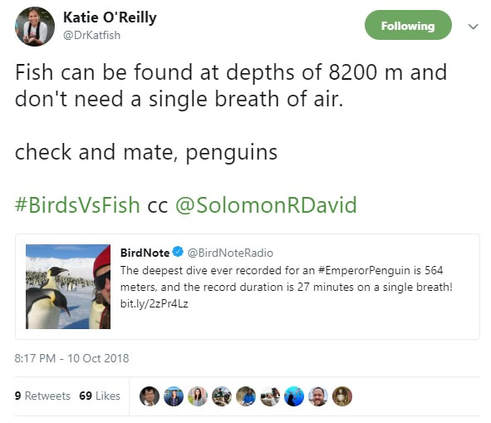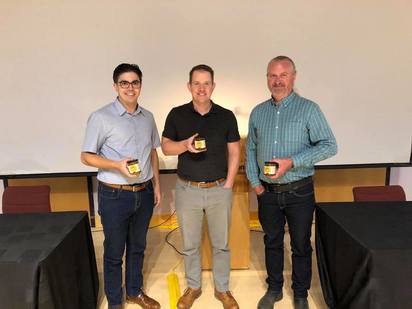|
There has been an ongoing debate on Twitter about which is the better taxa: #BirdsVsFish. This debate stemmed from some friendly trash tweeting in 2015 between Patrick Doran (@pjdgreatlakes), Director of Conservation at the Nature Conservancy in Michigan, and Solomon David (@SolomonRDavid), an Assistant Professor at Nichols State University. Since then, the #BirdsVsFishdebate has grown to a much larger audience, with scientists vehemently (but kindly) defending their study taxa. The #BirdsVsFish debate is fun for me because I have a passion for both birds and fish. In my present position as a Visiting Fellow with Fisheries and Oceans Canada, my research is dedicated to the conservation and recovery of freshwater fishes. However, I didn’t start my research career studying fishes, in fact, my research career began as an undergraduate in Connecticut studying migratory waterbirds. Studying birds is what got me excited about doing conservation research, but I’ve now dedicated my career to conserving fish! Clearly I’m torn in the #BirdsVsFishdebate! A great part of the #BirdsVsFishdebate, and more broadly social media, is how it provides a platform for scientists to talk about their work or study species. I would argue that one of the most important jobs of a scientist is to communicate their science (see the Twitter hashtag #scicomm to see what scientists are doing all around the world). There are many outlets for scientists to communicate their work and the choice is largely dependent on the intended audience. Most often, scientists write technical reports or peer-reviewed journal articles to satisfy professional duties, but these outlets are rarely read by people outside of their scientific discipline and may be inaccessible to people that lack journal or magazine subscriptions. As such, scientists are frequently getting involved in other forms of communication, including writing for blogs (like this one!) and through social media engagement like #BirdsVsFish. Social media engagement can provide several benefits to scientists that have only recently been realized. For academics or those publishing in the peer-reviewed literature, highly tweeted journal articles have been demonstrated to be more frequently cited than less tweeted articles, and maintaining a social media presence can allow users to access new research coming out in their fields. Outside of academia, engaging in social media as a biodiversity professional can lead to new connections with other professionals, it can provide a platform for you to enhance the outreach of your science, and it can inspire others to engage in science. As community members with an interest in protecting biodiversity, we have a responsibility to communicate why biodiversity is important and how it impacts each and every one of us on a daily basis. For me, I choose to tweet, write blogs, give oral presentations at workshops and conferences, write technical reports, and write peer-reviewed journal articles. As well, if you lend me your ear, I will talk it off about the diversity of fishes in Canada. How do you choose to communicate your science? Karl Lamothe is a Visiting Fellow at the Great Lakes Laboratory for Fisheries and Aquatic Sciences with Fisheries and Oceans Canada. In his current position, Karl is working towards improving the science of species reintroductions for freshwater fishes protected under the Species at Risk Act. Karl received his PhD from the University of Toronto where he was interested in ways to measure the resilience of freshwater ecosystems to human disturbances. Karl is active on Twitter: @KarlLamothe and you can read more about his research on his website: http://www.karllamothe.com.
0 Comments
Leave a Reply. |
ELB MembersBlogs are written by ELB members who want to share their stories about Ontario's biodiversity. Archives
January 2023
Categories
All
|



 RSS Feed
RSS Feed